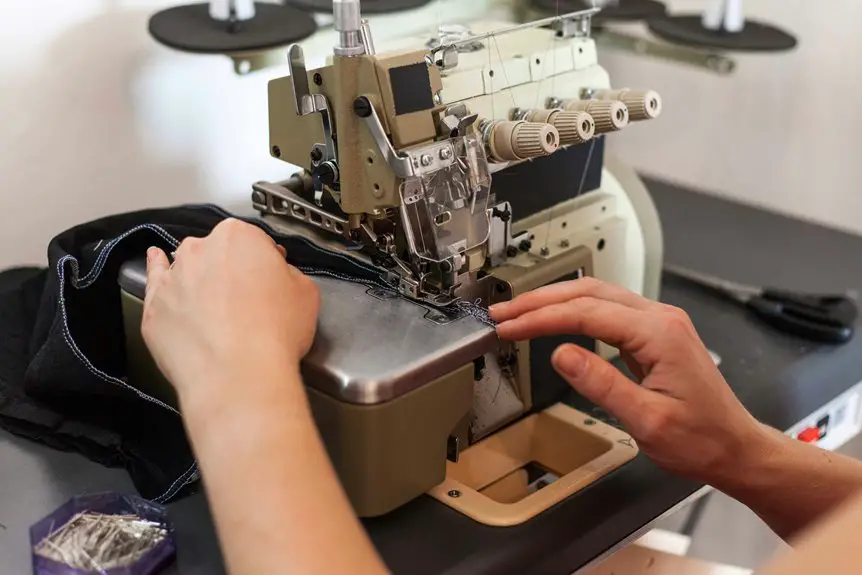To sew a perfect hem on double gauze fabric, start by washing and gently pressing it to prevent shrinking and soften fibers. Choose a neat hem style like a double fold or rolled hem to handle its soft, airy texture. Pin carefully, use a shorter stitch length, and sew slowly without stretching the fabric. Press the hem gently afterward to set stitches and avoid puckering. Keep these tips in mind, and you’ll be ready to master details that enhance its delicate look.
Table of Contents
Key Takeaways
- Pre-wash, dry, and gently press double gauze fabric to pre-shrink and soften before hemming.
- Use a double fold or rolled hem technique to accommodate the fabric’s softness and prevent fraying.
- Pin or clip the hem securely and sew slowly with a short stitch length to control fabric movement.
- Avoid stretching the fabric while sewing and let it feed naturally under the presser foot for smooth edges.
- Press the hem gently with a warm iron using a pressing cloth, then steam to set stitches without damaging fabric.
Understanding the Characteristics of Double Gauze Fabric
Before you begin sewing, it’s important to understand that double gauze fabric has a unique texture and weight that affects how you handle and hem it.
This fabric consists of two lightweight layers of cotton loosely woven together, giving it a soft, airy feel with slight thickness. Because of its delicate weave, double gauze can shift or stretch easily, so you’ll need to handle it gently.
Its natural drape means your hem should be flexible, avoiding stiffness. Also, the fabric’s tendency to fray means you’ll want to finish edges carefully.
When hemming, consider that the double layers add bulk, so precise folding and pressing are essential for a clean finish. Knowing these traits helps you sew a hem that looks professional and lasts.
Preparing Your Fabric for Hemming
Knowing how double gauze behaves will help you prepare your fabric properly for hemming.
First, wash and dry your fabric to pre-shrink it and soften the fibers. This step prevents unexpected shrinking after hemming.
Next, press your fabric gently with a warm iron to smooth out wrinkles without compressing the texture. Use a pressing cloth to protect the delicate layers.
When cutting your fabric, add extra length for the hem allowance, typically about one inch.
Finally, use pins or fabric clips to secure the hem in place, aligning the edges carefully to maintain evenness.
Taking these preparation steps guarantees your hem will lie flat and look polished, setting a solid foundation for sewing a perfect hem on your double gauze fabric.
Choosing the Right Hemming Technique
Now that your fabric is ready, it’s time to choose the right hemming technique for your project.
You’ll want to reflect on common hemming options, the best stitch types for your fabric, and how to finish the edges neatly.
Picking the right method will make your hem look professional and last longer.
Common Hemming Options
Selecting the right hemming technique can make all the difference in your sewing project’s finish and durability. When working with double gauze fabric, you want a hem that complements its lightweight, slightly textured nature without adding bulk.
Here are some common hemming options to evaluate:
- Double Fold Hem: Folds fabric twice to enclose edges, providing a clean, durable finish.
- Rolled Hem: A narrow, delicate hem ideal for lightweight fabrics like double gauze.
- Bias Tape Hem: Uses bias tape for a decorative, reinforced edge.
- Serger Hem: Quickly finishes edges with a serger, preventing fraying while maintaining softness.
Choose the technique that best suits your garment’s style and your sewing skills for a professional, lasting hem.
Best Stitch Types
The stitch you choose plays an essential role in securing your hem while enhancing the fabric’s appearance and durability.
For double gauze fabric, a straight stitch works well for a clean, sturdy finish. Use a fine needle and a short stitch length to avoid puckering.
If you want flexibility, try a narrow zigzag stitch—it offers stretch without bulk. Hand stitching with a blind hem stitch can give an almost invisible finish, perfect for delicate projects.
Remember to test your chosen stitch on a fabric scrap first to verify it doesn’t distort or damage the layers.
Edge Finishing Methods
Although choosing the right hemming technique might seem straightforward, the edge finishing method you pick can greatly affect your garment’s durability and appearance.
When working with double gauze fabric, you want a finish that prevents fraying while maintaining softness. Here are some popular edge finishing methods to evaluate:
- Serger finish: Quickly trims and encloses edges for a clean, professional look.
- French seam: Encases raw edges, perfect for lightweight fabrics.
- Bias tape binding: Adds a decorative touch while securing edges firmly.
- Rolled hem: Creates a narrow, delicate finish ideal for hems and lightweight fabrics.
Essential Tools and Supplies for Sewing Double Gauze
To sew double gauze effectively, you’ll need the right tools at hand.
Focus on selecting the best thread and needles designed for lightweight fabrics, along with precise measuring supplies to guarantee accuracy.
Having these essentials will make your hemming process smoother and your finished garment look professional.
Must-Have Sewing Tools
When you’re ready to sew double gauze, having the right tools makes all the difference in achieving a clean, professional hem.
Double gauze’s softness and layers demand precision, so equip yourself well before starting. Here’s what you’ll need:
- Sharp fabric scissors for crisp, clean cuts without fraying
- Fine pins or clips to hold delicate layers without damaging the fabric
- A pressing cloth to protect the fabric while ironing hems flat
- A rotary cutter and mat for smooth, accurate edge trimming
With these tools, you’ll handle double gauze confidently and keep your project neat.
Avoid makeshift substitutes, as they can cause puckering or uneven hems. Keep these essentials close, and your sewing will flow smoothly from start to finish.
Best Thread and Needles
Choosing the right thread and needle plays a big role in sewing double gauze smoothly, just like having the proper tools.
You’ll want to use a fine, high-quality cotton or polyester thread that matches your fabric’s weight and color. This guarantees strong, nearly invisible seams without adding bulk.
For needles, choose a sharp, universal needle size 70/10 or 80/12. These sizes pierce the delicate, lightweight fabric cleanly without causing runs or snags.
If your double gauze is particularly soft or loosely woven, a microtex needle can give you extra precision.
Always test your thread and needle combination on a fabric scrap first to confirm smooth stitching. This preparation helps you avoid puckering and keeps your hem looking crisp and professional.
Essential Measuring Supplies
Accurate measurements form the foundation of any well-sewn hem, especially with delicate double gauze fabric.
To achieve precision, gather the right measuring supplies before you start. You’ll want tools that help you mark and measure without damaging the fabric’s softness.
Here are the essentials you should have on hand:
- A flexible measuring tape for easy, curved measurements
- Sharp fabric scissors to trim accurately
- Fine, washable fabric markers or tailor’s chalk for temporary markings
- Straight pins or fabric clips to hold hems in place without puckering
Using these supplies guarantees your hem is even and crisp, preventing mistakes that can be tricky to fix on double gauze.
Step-by-Step Guide to Sewing a Neat Hem
Sewing a neat hem requires just a few essential steps that you can easily follow to achieve professional results. First, press the fabric edge up by the desired hem allowance. Next, fold the edge under once more to enclose the raw edge, then press again. Pin or clip the hem in place to prevent shifting. Finally, sew close to the inner fold, keeping your stitches even.
| Step | Action | Tip |
|---|---|---|
| 1 | Press fabric edge | Use steam for sharp crease |
| 2 | Fold and press twice | Encloses raw edge neatly |
| 3 | Pin or clip hem | Prevents fabric movement |
| 4 | Stitch near inner fold | Keep stitches even and tight |
Tips to Prevent Puckering and Bulkiness
While following the steps to sew a neat hem sets a strong foundation, you might notice puckering or bulkiness if the fabric isn’t handled carefully.
To keep your double gauze hem smooth, try these tips:
- Use a sharp, fine needle to prevent snagging and pulling the fabric.
- Sew with a shorter stitch length to control fabric movement and reduce puckering.
- Press the hem gently with a warm iron, using a pressing cloth to avoid flattening the fabric’s texture.
- Avoid stretching the fabric as you sew; let it feed naturally under the presser foot.
Finishing Touches for a Professional Look
Even after you’ve sewn a neat hem, adding the right finishing touches can make your project look truly professional. Start by gently pressing the hem with a steam iron to set the stitches and flatten the fabric. Trim any loose threads carefully. If you want extra durability, consider topstitching close to the edge. Finally, check your hem alignment and make minor adjustments if necessary.
| Finishing Step | Purpose |
|---|---|
| Press with Steam | Sets stitches & smooths fabric |
| Trim Loose Threads | Clean, tidy appearance |
| Topstitch Edge | Adds durability & definition |
| Final Alignment Check | Guarantees even, straight hem line |
These details elevate your work, making the hem durable and visually crisp.
Frequently Asked Questions
Can Double Gauze Fabric Be Used for Baby Clothing?
You might think double gauze fabric is too delicate, but it’s actually perfect for baby clothing. Its softness and breathability keep your little one cozy while being durable enough to handle everyday wear and washing.
How Does Double Gauze Fabric Compare to Muslin?
You’ll find double gauze softer and more breathable than muslin, with a crinkled texture. Muslin’s smoother and often sturdier, but double gauze offers extra comfort, making it great for delicate baby clothing or summer wear.
Is Double Gauze Fabric Suitable for Summer Bedding?
You’ll find double gauze fabric perfect for summer bedding because it’s lightweight, breathable, and soft. It helps keep you cool and comfortable through warm nights, making it an excellent choice for hot weather sleep.
Can I Dye Double Gauze Fabric at Home?
You can dye double gauze fabric at home using fiber-reactive or all-purpose dyes. Just pre-wash it, follow dye instructions carefully, and handle gently to avoid damaging its soft, delicate layers during the process.
What Are Common Projects Made With Double Gauze Fabric?
You’ll find double gauze perfect for baby blankets, lightweight scarves, summer dresses, and cozy shirts. Its softness and breathability make it ideal for projects where comfort and gentle texture matter most.
- How to Shrink a Preshrunk Ringspun Cotton Shirt (Safely) - June 23, 2025
- Is Ringspun Cotton Preshrunk? Understanding Labels and Laundering - June 23, 2025
- The Best Ink for Screen Printing on 100% Ringspun Cotton - June 23, 2025






